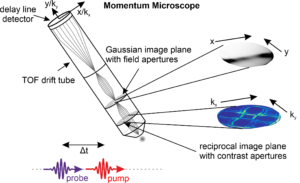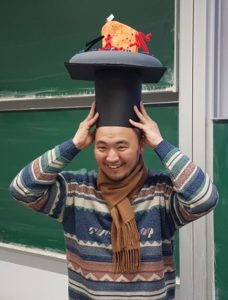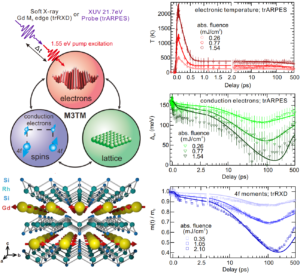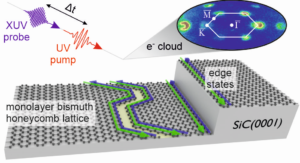Home
Welcome to the Dynamics of Correlated Materials group!
We are an experimental research group focusing on the investigation of ultrafast processes in strongly correlated materials. Our goal is the understanding of the fundamental interactions at play on the microscopic level in such materials, leading to complex behavior. We develop and employ complementary ultrafast techniques such as time- and angle-resolved photoelectron spectroscopy (trARPES) and time-resolved diffraction techniques to study those elementary interaction processes and couplings across ultrafast phase transitions.
News
SPIE proceedings paper published: Ultrafast spatiotemporal dynamics of a charge-density wave using femtosecond dark-field momentum microscopy
Mar 2023

Understanding phase competition and phase separation in quantum materials requires access to the spatiotemporal dynamics of electronic ordering phenomena on a micro- to nanometer length- and femtosecond timescale. While time- and angle-resolved photoemission (trARPES) experiments provide sensitivity to the femtosecond dynamics of electronic ordering, they typically lack the required spatial resolution. Here, we demonstrate ultrafast dark-field photoemission microscopy (PEEM) using a momentum microscope, providing access to ultrafast electronic order on the microscale. We investigate the prototypical Charge-Density Wave (CDW) compound TbTe3 in the vicinity of a buried crystal defect, demonstrating real- and reciprocal-space configurations combined with a pump-probe approach.
For more details, including a recording of the presentation at SPIE Photonics West 2023, see Proc. [more...]
For more details, including a recording of the presentation at SPIE Photonics West 2023, see Proc. [more...]
New paper in Nature Computational Science
Feb 2023

The electronic band structure and crystal structure are the two complementary identifiers of solid-state materials. Although convenient instruments and reconstruction algorithms have made large, empirical, crystal structure databases possible, extracting the quasiparticle dispersion (closely related to band structure) from photoemission band mapping data is currently limited by the available computational methods. To cope with the growing size and scale of photoemission data, here we develop a pipeline including probabilistic machine learning and the associated data processing, optimization, and evaluation methods for band-structure reconstruction, leveraging theoretical calculations. The pipeline reconstructs all 14 valence bands of a semiconductor and shows excellent performance on benchmarks and other materials datasets. The reconstruction uncovers previously inaccessible momentum-space structural information on both global and local [more...]
Thesis defended: Sang-Eun Lee
Dec 2022

Sang successfully defended his PhD thesis in Dec. 2022. Congratulations and best wishes for your future!
Paper published: Robust magnetic order upon ultrafast excitation of an antiferromagnet
Nov 2022

Understanding the microscopic mechanisms behind ultrafast magnetization dynamics remains an important issue in solid state physics. Numerous studies have successfully applied variations of three-temperature models to describe experimental ultrafast magnetization dynamics. By introducing effective temperatures for the transient electronic, lattice and spin degrees of freedom (see figure), the 3TM provides an intuitive, phenomenological approach for the quantitative analysis of ultrafast magnetization dynamics using three coupled differential equations to describe the mutual energy transfer between the subsystems. However, comparison of model predictions are often only made with one of the subsystems.
In our study (Adv. Mater. Interfaces 2201340 (2022)), we investigate the femtosecond dynamics of electronic temperature, sub-surface ferromagnetic ordering [more...]
In our study (Adv. Mater. Interfaces 2201340 (2022)), we investigate the femtosecond dynamics of electronic temperature, sub-surface ferromagnetic ordering [more...]
Paper published: Ultrafast Momentum-Resolved Hot Electron Dynamics in the Two-Dimensional Topological Insulator Bismuthene
Jun 2022

In the quest to continue Moore´s law, utilizing the electron´s spin degree of freedom poses a promising approach. A material class that intrinsically enables efficient spintronic applications are quantum spin Hall (QSH) insulators, also termed 2D topological insulators, as they allow for dissipationless spin-currents in their edges. However, exploiting the transport properties of such edge states is so far restricted to cryogenic temperatures, as only a few QSH materials with small bulk band gaps are available. Here, graphene-like 2D structures of heavy atoms, most notably bismuthene, i.e., a honeycomb lattice of Bi atoms on a semiconductor substrate, offer a route to QSH conductivity far beyond room-temperature due to their large spin-orbit coupling.
In our recent study [Maklar et al., Nano Letters (2022)], we present a detailed investigation of the ultrafast [more...]
In our recent study [Maklar et al., Nano Letters (2022)], we present a detailed investigation of the ultrafast [more...]